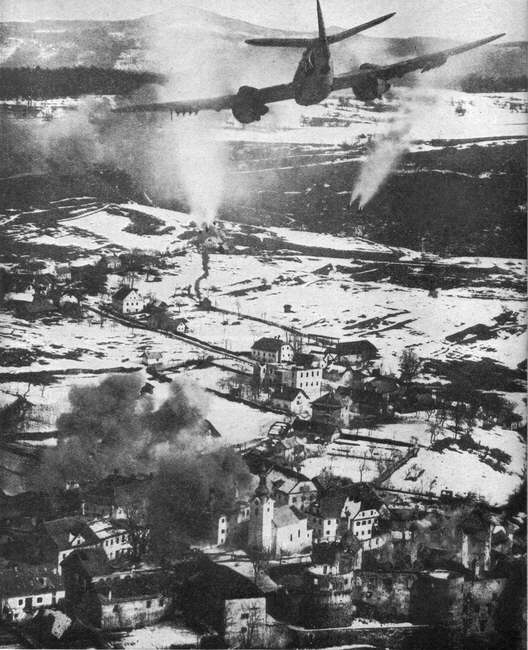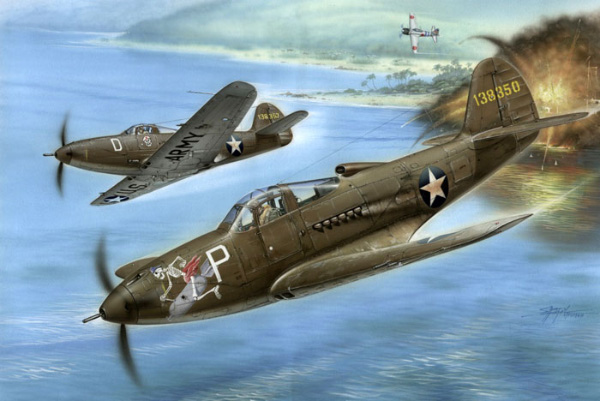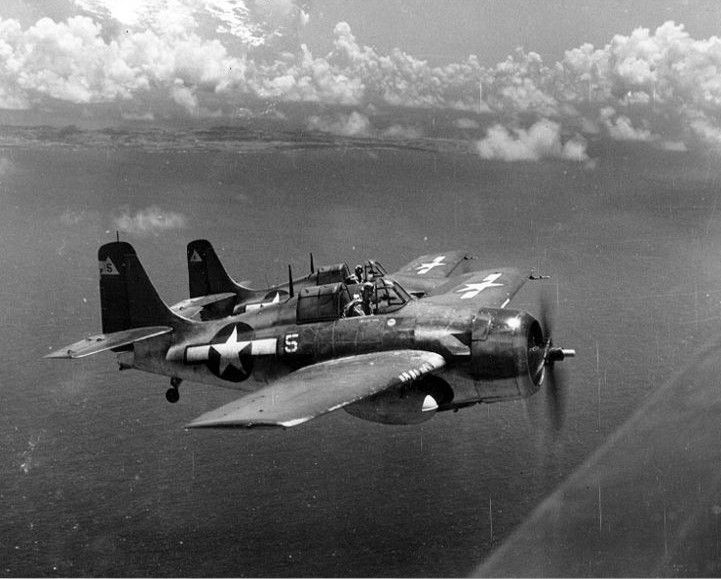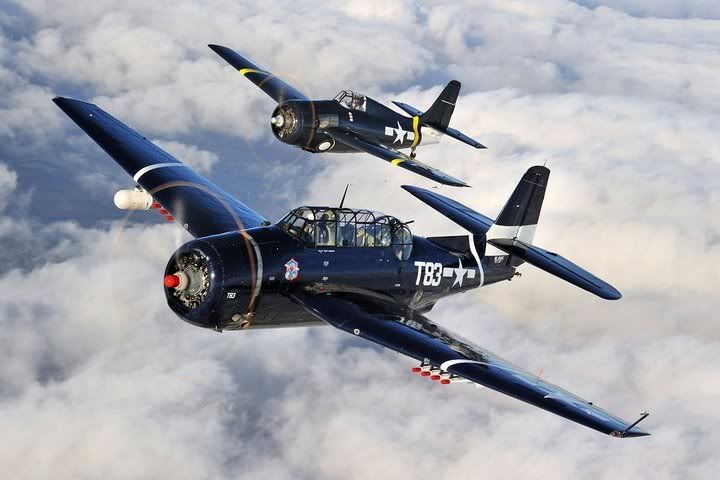Unlike World War I, in which aviation was dominated by personalities, the heroes of World War II were the airplanes themselves.
By September 1939, the German air force was superior in the skies as was evident during the Spanish Civil War (1936 - 1939) when the Luftwaffe easily claimed air superiority with bombing runs on Spanish towns. This was backed by speed records and precedent-setting develoipments. The Messerschmitt 109R set the then new world speed record by reaching just under 470 miles per hour.
Missing from their strategy as the war began was the presence of a long-range bomber, a factor that would prove crucial in the closing years of the war.
Emphasis on dive-bombers, capabale of making quick and short runs, led to the development of a series of aircraft known as Stukas. One of the early Stukas was the Junkers JU-87 dive-bomber. Capable of reaching 200 miles per hour, the JU-87 was a fixed-gear monoplane requiring a two-man crew.
Appearing at the same time was the Masserschmitt 110, a twin-engine fighter-bomber with the capacity to reach 350 miles per hour.
While proving effective at first, the JU-87 and ME-110, eventually failed the Luftwaffe in the first major air battle of the war, the Battle of Britain.
The Luftwaffe's full-scale aerial assault on the British was devised as a prelude to eventual land, sea, and air invasion of England. But they were unable to completely destroy the Royal Air Force (R.A.F.) of England. Two British fighters were able to inflict equal damage to the Luftwaffe.
 The Hawker Hurricane was a durable and highly maneuverable fighter plane capable of unleashing massive firepower from its twelve machine guns.
The Hawker Hurricane was a durable and highly maneuverable fighter plane capable of unleashing massive firepower from its twelve machine guns.
 The Supermarine Spitfire was also highly maneuverable, and capable of reaching speeds up to 350 miles per hour. A unique feature of the Spitfire was the ability to concentrate fire from its eight machine guns on a very small portion of a target. Because of its all-metal construction, the Spitfire proved a more difficult target to disable than its partially fabricated cousin, the Hurricane (built from metal and fabric).
The Supermarine Spitfire was also highly maneuverable, and capable of reaching speeds up to 350 miles per hour. A unique feature of the Spitfire was the ability to concentrate fire from its eight machine guns on a very small portion of a target. Because of its all-metal construction, the Spitfire proved a more difficult target to disable than its partially fabricated cousin, the Hurricane (built from metal and fabric).
The Germans altered their strategy to focus on night bombings of British cities and the R.A.F. countered by unleashing the Bristol Beaufighter; a twin-engine, radar-equipped fighter that carried a crew of two. The radar enabled the Beaufighter to track Luftwaffe bombers at night.

A Bristol Beaufighter X of No.19 Squadron, SAAF, attacking the German-occupied town of Zuzemberk, Yugoslavia. The Bristol Beaufighter was the first dedicated night fighter to enter RAF Service. Superceded by the Mosquito in that role, the Beaufighter went on to serve as a deadly anti-shipping weapon, and to earn the nickname "whispering death" over the jungles of Burma.
Both England and Germany developed innovative aircraft from their wartime assembly lines during the course of the war.
The United States remained directly out of the air war until December 1941 when the Japanese attack on Pearl Harbor left no other option. One of the Japanese carrier-based airplanes that carried out the assault on American naval forces in Hawaii was the Aichi Type 99. The all-metal bomber was a single-engine, fixed-gear monoplane armed with three cannons. The Zero was lightweight and much faster than the Aichi, with a maximum speed approaching 340 miles per hour. The Zero was also light on armor plating, leaving its fuel tanks susceptible to explosions.
Thus began America's three-year entry into the war. At the onset of American entry into the war, the United States Army Air Corps was reliant upon two aircraft as fighters: the Bell P-39 and the Curtiss-Wright P-40.

Bell P-39

Curtiss-Wright P-40
American naval forces began the war with the Grumman F4F Wildcat as their main carrier-based fighter.

While inferior to the Zero in raw performance capabilities, the Wildcat's durability and firepower led to numerous victories over the Japanese figher in the Pacific.
During the winter of 1941, the United States Army Air Corps began taking delivery of the Lockheed P-38 Lightning, evolving into one of the classics of the war era. It operated in all theaters as an interceptor, a figher-bomber, and as a reconnaissance plane. The single-seater, built with twin engines and a twin tail assembly, operated comfortably at 20,000 feet, with a maximum speed of almost 400 miles per hour. Armed with four fifty-caliber machines guns and a twenty-millimeter cannon, the P-38 series saw extensive use as a figher in the Pacific.
Restored P-38 Lightning
American aircraft played a crucial role in emerging victorious from a succession of key air and sea battles in the Pacific during the spring and summer of 1942. The TBM Avenger and the Douglas SBD Dauntless were the two main carrier-based attack planes during the battle for Midway. A so-called "wing-bender", the Avenger actually debuted as a torpedo and dive-bomber during the June 1942 battle for Midway.

TBM Avenger
Despite suffering initial losses to Japanese Zoroes at Midway, the Dauntless emerged as a potent weapon to aircraft in the air and to ships at sea. Configured to house a rear gunner as a member of its two-man crew, the Dauntless took credit for helping sink four Japanese carriers during the four-day battle at Midway.
By the end of 1943, American naval forces had all but secured the skies over the Pacific with the introduction of teh Chance-Vought F4U Corsair and the Grumman F6F Hellcat. The Corsair had the distinction of being the heaviest carrier-based figher built up to that point. The Corsair was fast, with a maximum speed of over 400 mile per hour and was superior to the Zero in almost every respect. With six fifty-caliber machine guns and a launching capacity for eight five-inch rockets, the bent-wing Corsair was a feared and deadly nemesis to Japanese air forces.
While the Corsair and Hellcat controlled the skies, American bombers were able to launch limited attacks on the Japanese mainland. The North American B-25 Mitchell was devised as a smaller, so-called medium bomber. The twin-engine B-25 coudl carry only light payloads, but could pick up those payloads from the decks of American carriers based in the Pacific and deliver them where needed.
The European theater, being a land-based war, required a different mission for the airplane. Emphasis was put on long-range bombers and high-performance fighter escorts.
Two of the more prolific American bombers built to fulfill this mission were the Boeing B-17 Flying Fortress and the Consolidated B-24 Liberator. The B-17 was a four-engine heavy bomber that saw extensive action on daylight bombing runs over Germany. Extremely durable even under heavy attack, the B-17 earned its nickname from the awesome amount of firepower it was capable of delivering in defense of itself. Outfitted with six pairs of fifty-caliber machine guns (in turrets located uner, on top, and on both sides of the aircraft, in addition to the standard nose and tail turrets), the Flying Fortress was indeed just that.
The B-24 proved its worth as a heavy bomber in all corners of the world. While carrying a larger payload over greater distances than the B-17, the Liberator's only drawback was in its lower operating altitude. More susceptible to enemy ground fire and fighter attack, the B-24 achieved its greatest success on escorted bombing runs over German industrial cities.
Two fighters that provided escort service for the Allied bombers were the Republic P-47 Thunderbolt and the North American P-51 Mustang. In many ways the Thunderbolt and Mustang made heroes out of Allied bomber pilots by providing extensive and thorough coverage for U.S. and R.A.F. bombing runs. The P-47 was a single-engine fighter made of a nearly impenetrable skin. With a top speed of over 400 miles per hour, and armed with eight fifty-caliber machine guns, the P-47 realized immediate success as a fighter and a strafer, providing aerial support for ground troops.
The Mustang was capable of operating at ceilings exceeding 20,000 feet and provided excellent excort capacity for high-altitude, long-range bombers. With a maximum speed of almsot 440 miles per hour, the highly mobile P-51 also proved a deadly foe for the Focke-Wulf 190 and the Messerschmitt 109.
The final blow to the Axis powers was delivered by a heavy bomber of the U.S. Air Force, the Boeing B-29 Superfortress. Almost 100 feet long, the wingspan of 143 feet, the B-29 was a long-range bomber capable of reaching Japan from captured territories in Saipan and Guam, over 1,000 miles away. The four-engine aircraft featured the first pressurized cockpit, allowing crew members to remain conscious and alert even in high altitudes. With twelve fifty-caliber machine guns strategically located in turrets throughout the plane, the Superfortress was indeed a fortress in the sky. It was this plane that dropped the atomic bombs on the cities of Hiroshima and Nagasaki in August 1945, bringing the six-year war for world domination to a devastating end.
P-38 Lightning Photo Gallery (P-38 National Assocation & Museum)
http://www.p38assn.org/gallery.htm
No comments:
Post a Comment